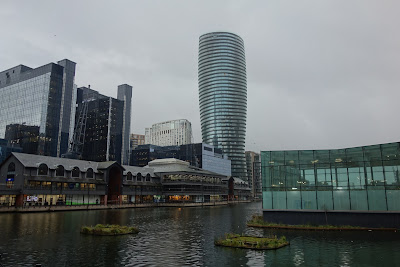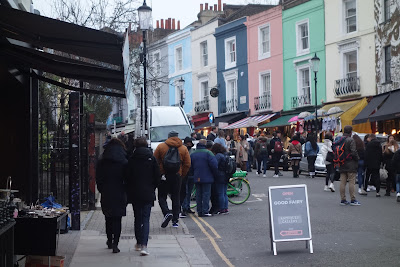Thursday, January 30, 2020:
Today we ventured to Greenwich in southeast London. Greenwich is the home to the Meridian Line, the Cutty Sark clipper ship, Greenwich Park, the Royal Observatory, the National Maritime Museum and the Old Royal Naval College with its celebrated Painted Hall; as such, there is a lot to see and do here. All these places are within walking distance of each other in a neighborhood that evokes a seaside village replete with plentiful fish & chip shops. We chose first to explore the Royal Naval College and quickly found out that the College alone is more than enough to occupy oneself all day.
 |
| Downtown Greenwich |
 |
| A Pub Across from Greenwich Park |
 |
| Home of Cecil Day-Lewis, Poet Laureate of the UK, and his son actor Daniel Day-Lewis |
 |
| The Cutty Sark at the End of Street with Canary Wharf in Far Distance |
 |
| The Royal Observatory in Greenwich Park |
Before even exploring the college we encountered the Greenwich Foot Tunnel which crosses beneath the Thames. Remarkably, the tunnel was opened in 1902. What an amazing engineering feat for its day. It takes less than 15 minutes to walk from one end to the other.
 |
| Entrance to Greenwich Foot Tunnel |
 |
| Inside the Tunnel |
We thoroughly enjoyed exploring the Old Royal Naval College. In the late 1600s and early 1700s the Royal Hospital for Seamen at Greenwich was created on this site on the instructions of Queen Mary II as a home for retired and injured sailors. The architect was the prolific Christopher Wren. In 1873, four years after the hospital closed, the buildings were converted to a training establishment for the Royal Navy. However, this was an important site even in the 1400s....
 |
| Queen Anne Court |
 |
| Queen's House, Royal Residence, seen from Old Royal Naval College |
Prior to the Old Royal Naval College and prior to the Royal Hospital for Seamen, this exact site was the home of Greenwich Palace where Henry VIII was born in 1491 to Elizabeth of York. The Palace was a favorite place of the king throughout his life. In 1509 Henry married Catherine of Aragon, his first wife, here. In 1536 Henry's second wife, Anne Boleyn, was arrested here for the crime of adultery and taken by boat across the Thames to the Tower of London to be executed. Greenwich was where, at age 44 in the year 1537, Henry was thrown off a horse and as a result of his injuries was unable to exercise and became the corpulent king we remember today. Greenwich Palace was also where Henry's daughters (and future queens) Mary and Elizabeth were born. The Palace was demolished after being damaged in the civil war in the 1600s.

Inside the Old Royal Naval College we discovered "the UK's Sistine Chapel", the beautiful Painted Hall. The stunning ceiling murals here were painted by Sir James Thornhill between 1707 and 1726 to celebrate Britain's growing maritime power. It is interesting to examine the murals' symbolism, religious and political imagery that served to both edify and deceive people at that time.
 |
| The Painted Hall |
 |
| Mural Depicting William III and Mary II with Catholic French King Louis XIV at their feet |
 |
| The Magnificent Great Dome Built by Christopher Wren |


























































